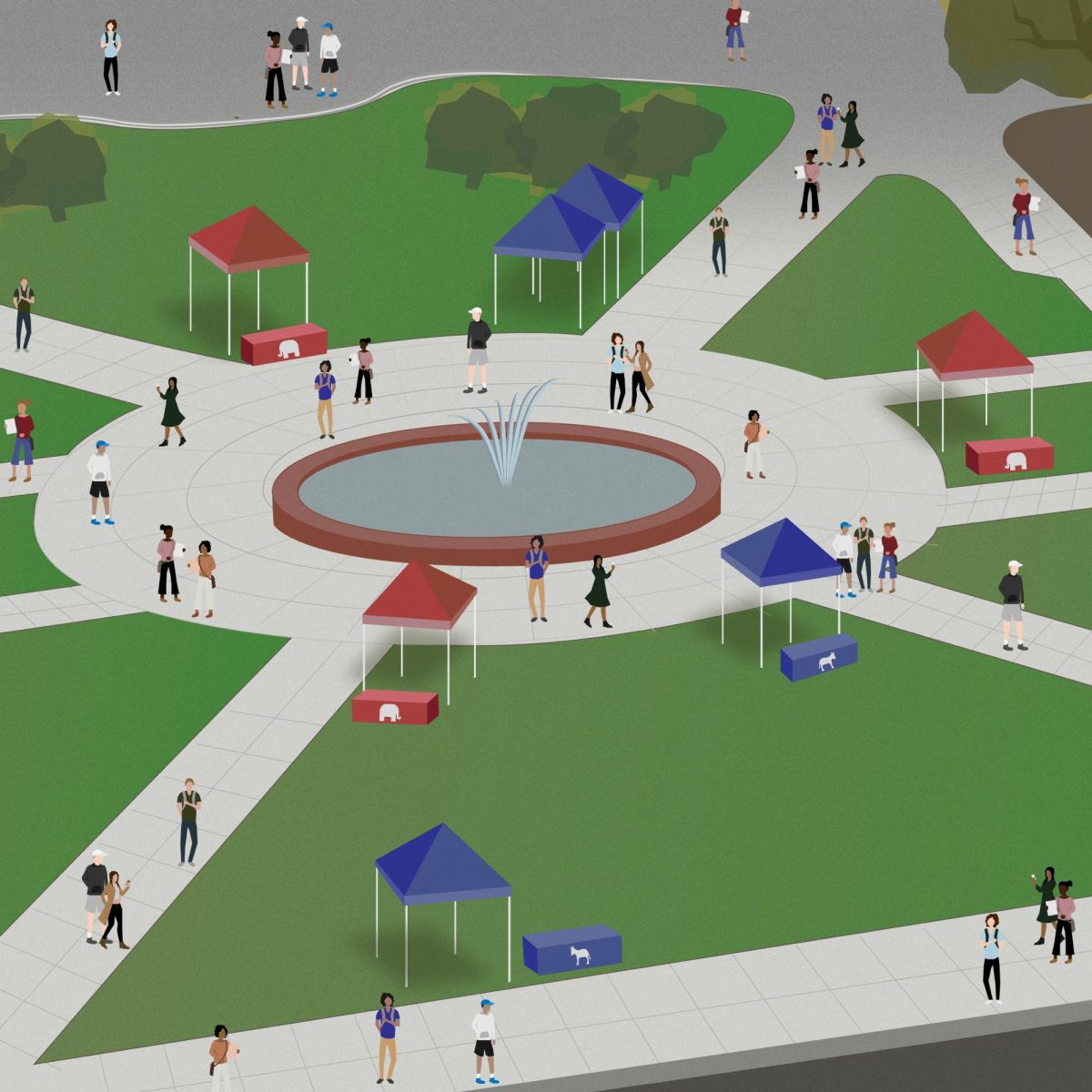Video by Emily Gaare
Tucked into the eighth floor of a Lake Street apartment building, five women call a jumbled four-bedroom home for the semester. When we walked into the apartment, though, it was full of people. The Wisconsin-Purdue game played for an audience of droopy-eyed college students who only awakened for the best and worst plays. It was warm and welcoming, but not at all what you’d expect for a hair salon.
Only when University of Wisconsin junior Jackie Cofsky brought out her shears, comb and barber’s cape was it evident that this was Cofsky Cuts, a hair-cutting business owned and operated by Cofsky and a friend, created to serve the stylistic needs of broke college students.
With college becoming more and more expensive, students are more dedicated than ever to trying to make an extra buck. That dedication, when applied seriously, can turn into creative solutions that help students satisfy their needs and achieve their goals — all in the form of side hustles.
Approximately 44 million Americans maintain a side hustle of some sort. Side hustles are flexible sources of income usually to supplement a full-time or part-time job. They can come in many forms, including freelance work, resale work and even starting a small business.
The internet and social media have been huge factors in the proliferation of side hustles — first with eBay and Facebook Marketplace, and later with social media platforms such as Instagram as fast replacements for word-of-mouth marketing.
Hustling for cash
This popularity is pronounced among college students. The freedom and relative newfound ease of marketing in a social media-minded age means side hustles lend themselves particularly well to this busy, media-savvy demographic.
University of Wisconsin junior Annaliese Duerr, owner of Just the Dip, a dip powder nail business run out of her apartment, said the freedom to set her own schedule was one of the biggest draws to having her own business rather than working a traditional job.
“[In a traditional job] you have to work when your boss says you have to work,” Duerr said. “And that can be really hard, especially when your schedule isn’t always the same. Like on exam weeks, you may still have to work just as much as you have to work on any other week, which makes it hard to study more. And so by doing a side hustle or doing your own business, you can create your own schedule.”
Duerr and her business partner, fellow junior Amanda Jackson, who runs social media for Just the Dip, work 10 to 15 hours per week on their business, which now turns enough profit that Duerr was able to quit her traditional job. Duerr said since she is able to set her own schedule, this number is not necessarily set in stone. This way, during exam weeks she might only take four to six appointments, when usually she schedules around 10.
But there are other elements that make side hustles preferable to traditional jobs.
Jackie Cofsky, owner of Cofsky Cuts, an underground, pay-as-you-see-fit hair cutting business, said being able to make money on a flexible schedule and being her own boss are her favorite elements of working a side hustle. Her business partner, UW junior Annabelle Shultz, added that the social aspect of their work is also very rewarding.
“Cutting so many people’s hair and everything … you just meet so many random people,” Shultz said. “No clue who I’m posting half the time and I’m like, ‘Where did we find this person?’”
And yet, the conversations and relationships that emerge with their customers are very rewarding. Both women were excited about their ability to connect with their clients over moments large and small because of the conversations that happen during the haircuts.
Cofsky said sometimes this means sending a ‘good luck’ text before a client’s exam, but sometimes there’s an opportunity to celebrate an accomplishment.
“I hear fun things about them,” Cofsky said. “Like one of the boys just ran the New York Marathon and killed it. And so I texted him and was like, ‘I’m so proud.’”
Side hustles do more than bring income
A side hustle may also solidify a career path, rather than make profit right off the bat.
UW junior Deirdra Lambright, owner of Sweets 4 Dayz, a cookie, cupcake and cakepop bakery, runs her side hustle while still a student because she wants to be able to turn it into a full-time career after college.
“It’s my own money,” Lambright said. “Whatever I make I just put back into it. I don’t take any of its profit right now. Honestly, I’m working to grow it and not really to make money from it.”
Lambright said she’s wanted to have a baking business for years and debated going to school for baking. Eventually, however, she decided to teach herself and dedicate her academics to learning how to actually run a business.
Lambright said she applies the lessons she learns at the UW School of Business to running her own. Her work over this past semester included a presentation she created about working in versus on your business, she said.
“I enjoyed this year a lot because I feel like I’m actually taking classes that help me with my business … like being able to do that presentation of working in your business versus working on your business was a lot of research just on my own to realize, ‘wow, there’s some things I could be doing differently to … make my own business better,’” Lambright said.
Additionally, side hustles teach lessons through hands-on experience that will last a lifetime. The experience with networking and communication is especially applicable outside of the work they currently do, Jackson said.
Shultz is a computer science major and wants to work in cyber security, but she still feels the experience Cofsky Cuts has given her will be helpful in that work, she explained.
“I’m fully putting this on my resume, straight up … one great resume builder,” Shultz said. “But also … at this point, I’ve figured out that I’m decent at marketing stuff and just kind of feeling like I can run something myself. … So although it has really nothing to do with my major in that sense, I don’t really want to go into just sitting at a desk coding all the time. I really want to make sure that I can always be talking to people and everything. And I think this obviously helps because we’re meeting so many people.”
Cofsky agreed that the ability to talk with anyone about anything, which she learned largely because of Cofsky Cuts, will stay with her throughout her career. Additionally, Duerr and Jackson also noted that Just the Dip had helped refine their people skills. Duerr is a nursing student and Jackson is majoring in communication sciences and disorders, but they both felt that holding conversations and working with strangers on a daily basis would help them navigate communication in professional — as well as personal — settings.
Time, effort and a learning curve
Having your own business and working for yourself can be tough, but facing those challenges can teach valuable lessons.
Duerr explained how her side hustle changed her habits as she learned better time management.
“Time management, I feel like has been huge for this,” Duerr said. “… Especially now that I’m putting the sign-up sheets two weeks in advance online. That means that I have to know exactly what I’m doing for homework that week, what I have due and what I’m doing, and how long it’s going to take. And then when I go to do my homework, I have to make sure that I’m being productive because I can’t cancel the appointments that I have, but I still need to get my work done.”
One common challenge among student entrepreneurs is the time spent on aspects outside of performing the service or creating the good. Advertising, communicating with potential clients, running social media accounts, accounting and research are some of as tasks that had to be balanced alongside everything else.
Lambright estimated that she plans for about eight to 10 hours of work in and on her business each week, though very little of that time is spent baking.
“Honestly, more of it is the external work as of now,” Lambright said. “… Even if I don’t have orders, I’m still going to do that time. It’s like, you know, contacting people, emailing, doing my accounting, social media and trying to get new customers. And then the baking, I would say, during the school year, I get, like, three to four orders a month.”
There was also a universal willingness to learn and improve their respective crafts before they ever started charging for them.
Cofsky Cuts originated with Cofsky and her friend cutting each others’ hair in the Witte Residence Hall bathrooms. Later, she became known for giving free haircuts and started charging even after that. This free-of-charge period gave Cofsky time to become more confident and upgrade from kitchen scissors to a pair of hair shears and a buzzing kit.
Similarly, Lambright spent countless hours trying to perfect each recipe in her repertoire. And Duerr practiced the dip powder technique on herself and her friends for a whole summer before starting up her business. As demand grew, she realized the business potential of her nail kit.
“I decided I could actually make some good money off of this,” Duerr said
The learning doesn’t end when the business starts up, however. To keep their businesses moving, side hustlers often learn on the job, Lambright said. They become proactive about searching out more information to solve problems, meeting new customer needs and looking for ways to expand their business.
In order to continue this learning process, social media is a main source of research for student entrepreneurs.
“I’ve done a lot of personal research on just ways to do dip better,” Duerr said. “[On Facebook] they have a lot of tips and tricks on there of how to do things better — make it easier, make it go faster. … I’ve watched YouTube videos on how to use the products, more just [to] improve the results, like how long the nails will stay.”
Duerr also wants to learn new techniques, such as ombre and color blocking to expand her line of services.
Cofsky Cuts has recently expanded to include layers and bangs in their services, both of which Cofsky learned to do on YouTube. Additionally, after developing a sort of cult-like following, they decided to make merchandise. The beanies read, “Sorry we fucked up” to make it seem like customers who wear them are doing so to cover a bad haircut.
Lambright also uses YouTube to discover new recipes and techniques. She said that someday she will have a consistent set of recipes, but in the meantime, she tries to find and perfect new ones to see what customers like, develop her own skills and find what works. She also works to develop her brand through her blog and social media accounts.
“You have a certain item that you’re selling to people but if you’re not a good person, they don’t like you,” Lambright said about branding yourself. “They’re going to be less likely to buy. … You can even see people — they don’t have super great products, but if their brand and their person is … good enough, then people will still buy it.”
The driving forces
In order to continue fulfilling their goals, whether they be to make a little profit for themselves or to build a business for their future, the student entrepreneurs each explained specific motivating factors that made their work manageable.
One common motivator was the work itself. Whether it was baking, cutting hair, running social media or doing nails, the side hustlers did what fit their interests and passions to keep themselves satisfied with their work.
Lambright, for example, has had a passion for baking since she was young.
“[In Girl Scouts,] we’d have these Christmas bake sales every year,” Lambright said. “And we would literally bake on weekends for like three days straight. And half of us would stay and bake and half of us would go and sell … and I was like, ‘I think I’ll stay and bake.’ So I just got really into baking during that time and realized that I think that’s what I want to do.”
Another motivator was the support of friends and family.
“I told my parents and they were just like, ‘I don’t understand,’” Shultz said. “I was like, ‘No, it’s great.’ And they’re like, ‘Okay, sounds good.’ But my brother’s out there, and I told him and he was like, ‘Sure, whatever makes you happy.’”
This sentiment was echoed among the other entrepreneurs, whose friends and family were either very supportive or bewildered, but still respectful.
In fact, some went beyond that. Lambright’s parents are both entrepreneurs and were able to offer advice along the way. Duerr’s mother is an accountant and plans to help Duerr file taxes for Just the Dip.
“Just do it”
Side hustles are becoming more popular for college students for a reason. These three businesses show that with the right circumstances, a little luck and some good time management skills, side hustles are often a viable option for achieving one’s goals in college. They can aid in building one’s career, help make a little money on the side or even replace a traditional job altogether.
The women of Just the Dip, Cofsky Cuts and Sweets 4 Dayz had some words of advice to anyone looking to become their own boss and start their own side hustle.
“Make sure you have friends that support you,” Duerr said. “Honestly, when I was first starting out … I would do [my friends’] nails and they would post it all over Instagram. Even though when I was first starting out they didn’t look that great, they were supporting me … You will get clientele if you really work for it and if you’re good at what you do.”
Cofsky recommended maintaining a friendly environment, having a nice place to work and building up a decent reputation before starting to charge for services. After all, she started out in a Witte bathroom with a pair of kitchen scissors, and it would be years before she would take the business to where it is now.
Shultz agreed with Cofsky, and added that jumping in before you might feel ready can actually be a great option for starting a side hustle.
“Just do it, honestly,” Shultz said. “Even … if you don’t think it’s going to be crazy big or anything, if you really enjoy what you’re trying to do with it, it doesn’t hurt to try at all. … And don’t take it too seriously.”
Keeping a lighthearted attitude about the business has made Cofsky Cuts the success it is, Shultz said. It keeps the work fun, which makes it manageable and allows for the women to be creative about expanding their business.
The idea Shultz also mentioned of jumping in and learning on the go was common. Lambright reiterated some of this sentiment in her words of wisdom.
“I feel like the Nike sign — just do it,” Lambright said. “Like, if you’re scared or nervous about not feeling totally prepared, learning along the way isn’t always a bad thing. So if you really want to do it, then just start it and learn from there, as well as try to prioritize your time in the best way possible.”
Lambright also highlighted consistency as a way to maintain that initial momentum.
Finally, as a bonus, Lambright shared advice her father had given her which inspired her to become her own boss.
“He said, ‘Well, when you’re working under someone else, you can only push yourself as far as that business is going, but when you’re working on yourself, you can decide for yourself how far you want to go,’” Lambright said.
For further information, these fellow Badgers can be found online in the following places:
Just the Dip — Annaliese Duerr, Amanda Jackson
Instagram: @just_the_dip
Cofsky Cuts — Jackie Cofsky, Annabelle Shultz
Instagram: @cofsky_cuts
Sweets 4 Dayz — Deirdra Lambert
Instagram: @ddsweets4dayz








